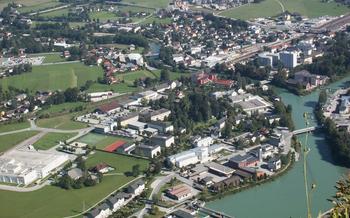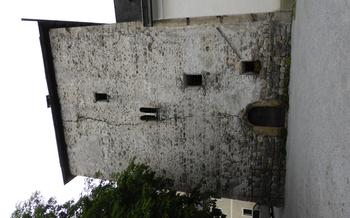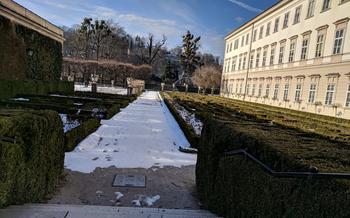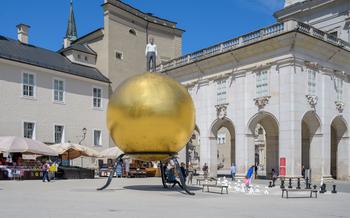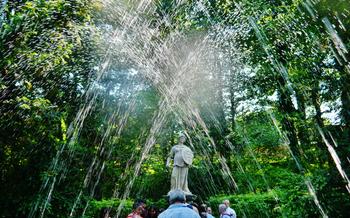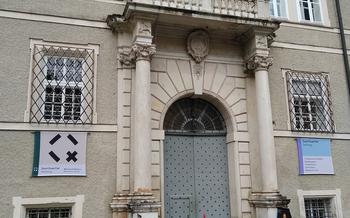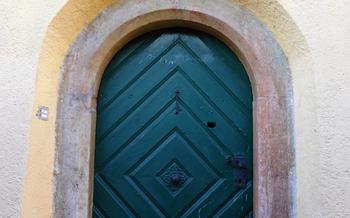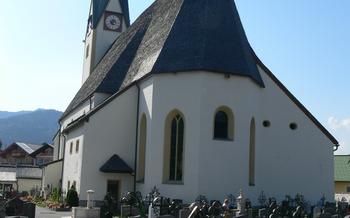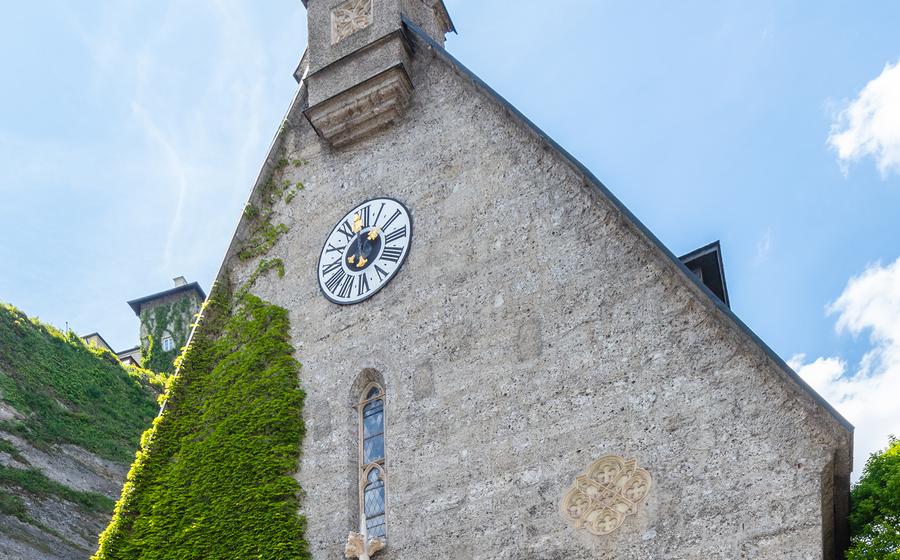
St. Blaise's Church
- St. Blaise's Church: A Baroque Masterpiece in Salzburg
- History and Origins of St Blaise's Church
- Architectural Marvels of St. Blaise's Church
- Exploring the Interior of St. Blaise's Church
- St. Blaise's Church and the Mirabell Gardens
- St. Blaise's Church in the Context of Salzburg's Baroque Architecture
- The Legacy of Archbishop Wolf Dietrich von Raitenau
- St. Blaise's Church in the Salzburg Festival
- St. Blaise's Church and Religious Observances
- Practical Information for Visitors
- Getting to St. Blaise's Church
- Things to Do Nearby
- Tips for Photography Enthusiasts
- Historical Anecdotes and Legends
- Insider Tip: Secret Passage
St. Blaise's Church: A Baroque Masterpiece in Salzburg
St. Blaise's Church, a stunning example of Baroque architecture, stands as a testament to the artistry and devotion that shaped Salzburg's religious and cultural landscape. Its origins date back to the 13th century when a modest chapel dedicated to St. Blaise, the patron saint of wool combers and throat ailments, stood on this site. Over the centuries, the church underwent several transformations, culminating in its grand Baroque reconstruction in the 17th century, which bestowed upon it the majestic appearance it boasts today.
The exterior of St. Blaise's Church is a feast for the eyes. Its elaborate facade, adorned with intricate carvings and sculptures, draws the gaze upward to the twin towers that dominate the cityscape. The most distinctive feature of the church, however, is its pair of onion-shaped domes, a hallmark of Salzburg's Baroque architecture, which add a touch of whimsy and grandeur to the skyline.
Step inside St. Blaise's Church, and prepare to be awed by its opulent interior. The nave and aisles are adorned with stunning frescoes depicting biblical scenes, allegorical figures, and the lives of saints, creating a sense of awe and wonder. The church's numerous altars, adorned with gold leaf, intricate carvings, and exquisite paintings, are a testament to the skill and devotion of the Baroque artisans who created them. Among the highlights of the church's interior is its collection of religious art, including sculptures, paintings, and reliquaries, which offer a fascinating glimpse into the artistic and spiritual significance of this sacred space.
History and Origins of St Blaise's Church
In its humble beginnings, St. Blaise's Church was merely a modest chapel dedicated to St. Blaise, the patron saint of wool combers and throat ailments. Constructed during the 13th century, this small chapel served the spiritual needs of the local community. As Salzburg's significance grew in the Middle Ages, the church underwent significant expansion and fortification, reflecting the city's increasing prosperity and importance. The medieval transformation of St. Blaise's Church mirrored the city's evolving status and its growing role as a religious and cultural center.
During the 17th century, Archbishop Wolf Dietrich von Raitenau embarked on an ambitious project to transform Salzburg into a Baroque masterpiece. This period marked a pivotal moment in the history of St. Blaise's Church, as it underwent a major reconstruction and expansion under the archbishop's patronage. The original chapel was demolished, and in its place arose the magnificent Baroque church that stands today, a testament to the archbishop's vision and the city's commitment to the Baroque style.
Architectural Marvels of St. Blaise's Church
St. Blaise's Church stands as a testament to the grandeur of Baroque architecture, showcasing a harmonious blend of intricate details and imposing structures. The church's facade is a masterpiece in itself, adorned with exquisite carvings and sculptures that depict scenes from the life of St. Blaise and other religious figures. The twin towers that flank the facade, topped with striking onion-shaped domes, dominate the cityscape and serve as a beacon for visitors from afar.
Inside the church, the architectural marvels continue to impress. The nave, with its soaring height and elegant arches, creates a sense of awe and wonder. The aisles, lined with side chapels, offer a glimpse into the lives of various saints and provide a serene atmosphere for contemplation. The transepts, with their intricate altars and frescoes, add to the visual splendor of the interior. The chancel, the most sacred part of the church, features a magnificent high altar that is a testament to the skill and artistry of Baroque craftsmen.
Exploring the Interior of St. Blaise's Church
St. Blaise's Church boasts an opulent interior that is a testament to the grandeur of the Baroque era. The walls and ceilings are adorned with stunning frescoes, painted by some of the most talented artists of the time. These frescoes depict biblical scenes, allegorical figures, and the lives of saints, bringing the stories of the Bible to life in vibrant colors and intricate detail.
The church also houses numerous altars, each one a masterpiece of craftsmanship. The main altar, dedicated to St. Blaise, is particularly impressive, with its intricate carvings, gold leaf, and exquisite paintings. The side altars are also noteworthy, each with its own unique design and iconography.
In addition to the frescoes and altars, St. Blaise's Church is home to a valuable collection of religious art. This includes sculptures, paintings, and reliquaries, many of which date back to the Middle Ages. These works of art not only enhance the beauty of the church but also provide a glimpse into the rich spiritual and cultural heritage of Salzburg.
St. Blaise's Church and the Mirabell Gardens
St. Blaise's Church stands in close proximity to the Mirabell Gardens, another iconic landmark of Salzburg. These two attractions complement each other beautifully, offering visitors a rich cultural and historical experience. The Mirabell Gardens, with their manicured lawns, ornate fountains, and stunning flowerbeds, provide a picturesque backdrop to the church's Baroque grandeur.
From the gardens, visitors can enjoy panoramic views of the city and the surrounding Alps. The gardens offer a tranquil oasis amidst the bustling city, inviting visitors to stroll along its paths, admire the sculptures and fountains, and soak in the beauty of the natural surroundings. The combination of St. Blaise's Church and the Mirabell Gardens creates a harmonious blend of architecture, nature, and history, making it a must-visit destination for anyone exploring Salzburg.
St. Blaise's Church in the Context of Salzburg's Baroque Architecture
Salzburg is renowned for its rich Baroque heritage, and St. Blaise's Church stands as a testament to the city's commitment to this architectural style. Built during the 17th century, the church exemplifies the exuberance and grandeur characteristic of Baroque architecture. Its intricate facade, adorned with elaborate carvings and sculptures, is a masterpiece in itself. The unique onion-shaped domes, a defining feature of Salzburg's Baroque skyline, symbolize the city's devotion to Catholicism and its close ties to the Holy Roman Empire.
The interior of St. Blaise's Church is equally impressive, with ornate frescoes covering the walls and ceilings, depicting biblical scenes, allegorical figures, and the lives of saints. The gilded altars, with their intricate carvings and exquisite paintings, add to the opulent atmosphere of the church. The overall grandeur of the space is further enhanced by the intricate layout, including the nave, aisles, transepts, and chancel, which create a sense of awe and reverence.
When compared to other notable Baroque churches in Salzburg, such as the Salzburg Cathedral and the Kollegienkirche, St. Blaise's Church holds its own with its unique features and contributions to the city's architectural landscape. While the Salzburg Cathedral is larger and more imposing, St. Blaise's Church offers a more intimate and personal experience, with its smaller size and intricate details. The Kollegienkirche, known for its stunning trompe-l'oeil ceiling frescoes, complements St. Blaise's Church by showcasing the diversity and richness of Salzburg's Baroque architecture.
Together, these three churches form a harmonious ensemble that defines Salzburg's unique character and showcases the city's dedication to the Baroque style. Whether viewed individually or as part of a larger tour of Salzburg's Baroque landmarks, St. Blaise's Church is a must-see for anyone interested in architecture, history, and the arts.
The Legacy of Archbishop Wolf Dietrich von Raitenau
Archbishop Wolf Dietrich von Raitenau was a visionary leader and passionate patron of the arts who played a pivotal role in shaping the architectural landscape of Salzburg. His ambitious building projects and his unwavering commitment to transforming the city into a Baroque masterpiece left an indelible mark on Salzburg's cultural heritage.
Archbishop Wolf Dietrich's patronage extended beyond St. Blaise's Church. He commissioned numerous other notable architectural projects, including the construction of the magnificent Salzburg Cathedral, the opulent Residenz Palace, and the enchanting Mirabell Palace and Gardens. These landmarks stand as testaments to his grand vision for the city and his dedication to elevating Salzburg's status as a cultural and artistic center.
Under Archbishop Wolf Dietrich's rule, Salzburg underwent a remarkable transformation, embracing the Baroque style with fervor. His architectural patronage not only beautified the city but also fostered a vibrant artistic community, attracting talented architects, artists, and craftsmen from across Europe.
Archbishop Wolf Dietrich's legacy extends far beyond his architectural achievements. He was a staunch advocate for education, establishing the University of Salzburg and reforming the school system to promote literacy and learning. His progressive policies and commitment to the arts laid the foundation for Salzburg's enduring reputation as a cultural powerhouse.
St. Blaise's Church in the Salzburg Festival
St. Blaise's Church holds a prominent place in the prestigious Salzburg Festival, one of the world's most renowned classical music festivals. Its exceptional acoustics, achieved through the church's unique architectural design, make it an ideal venue for concerts and performances. The reverberant interior, with its high vaulted ceilings and marble surfaces, creates a rich and immersive sound that enhances the musical experience.
Throughout the festival, St. Blaise's Church hosts a variety of concerts, from intimate chamber music recitals to grand orchestral performances. The church's intimate setting and close proximity to the audience create a unique atmosphere of intimacy and connection between the performers and the listeners.
Attending a concert at St. Blaise's Church during the Salzburg Festival is a truly memorable experience. The combination of stunning architecture, exceptional acoustics, and world-class performances creates a magical ambiance that captivates audiences and leaves them with lasting memories.
St. Blaise's Church and Religious Observances
St. Blaise's Church remains an active parish within the Roman Catholic Archdiocese of Salzburg, serving as a spiritual center for the local community. It plays a vital role in the religious life of the city, hosting various masses and religious services throughout the week. Visitors are welcome to attend these services and experience the church's vibrant spiritual atmosphere.
Regular masses are held in the church, typically on Sundays and weekdays, providing an opportunity for both locals and tourists to participate in worship and prayer. The church's interior, with its ornate decorations and sacred ambiance, creates a conducive environment for spiritual reflection and contemplation.
For those interested in delving deeper into the religious history and traditions associated with St. Blaise's Church, guided tours are available. These tours offer insights into the church's significance as a place of worship, its architectural features, and the stories of the saints and martyrs associated with it.
Whether seeking spiritual fulfillment or simply curious about the religious heritage of Salzburg, St. Blaise's Church offers a welcoming and enriching experience for visitors of all faiths.
Practical Information for Visitors
St. Blaise's Church welcomes visitors with open arms, offering them a chance to marvel at its architectural grandeur and spiritual significance.
Getting to St. Blaise's Church
St. Blaise's Church is conveniently located in the heart of Salzburg, making it easily accessible by various means of transportation. Visitors can take a leisurely stroll from the city center, enjoying the charm and ambiance of the historic streets. For those arriving by car, there are several parking garages and designated parking areas nearby, ensuring a hassle-free visit. The church's central location allows visitors to seamlessly integrate their visit with other attractions in the city, making it a must-see destination for any traveler exploring Salzburg's rich cultural heritage.
Things to Do Nearby
When visiting St. Blaise's Church, take the opportunity to explore the surrounding area and discover other notable attractions. Just a short walk away lies the magnificent Mirabell Gardens, a UNESCO World Heritage Site. These stunning gardens, laid out in the 17th century, feature intricate landscaping, elegant fountains, and meticulously manicured flower beds. Stroll through the gardens, admire the impressive sculptures and statues, and enjoy the serene atmosphere. The gardens also offer stunning views of the city and the surrounding Alps.
Another must-see attraction in the vicinity is Salzburg Cathedral, the seat of the Archbishop of Salzburg. This imposing Gothic masterpiece dominates the city's skyline with its twin towers and intricate facade. Step inside to admire the cathedral's grand interior, featuring soaring vaults, ornate altars, and beautiful stained-glass windows. The cathedral is also home to a museum that showcases its rich history and treasures.
Tips for Photography Enthusiasts
St. Blaise's Church presents a myriad of captivating photographic opportunities for enthusiasts. To capture the church's grandeur, position yourself at an angle that showcases its impressive facade, with the twin towers reaching towards the sky. Experiment with different perspectives to create dynamic compositions.
For optimal lighting, plan your visit during the golden hours of sunrise or sunset, when the warm, diffused light casts a magical glow on the church's exterior. On overcast days, the soft, even light can produce ethereal shots, emphasizing the intricate details of the facade.
Inside the church, the play of light and shadow creates a captivating atmosphere. Seek out the ornate frescoes and gilded altars, using natural light from the windows to illuminate their intricate details. Experiment with different shutter speeds to capture the movement of flickering candles, adding a touch of drama to your images.
Remember to respect the sanctity of the church during religious services, and always ask permission before photographing people or sensitive areas. With a keen eye and a patient approach, you'll capture stunning photographs that encapsulate the beauty and spirit of St. Blaise's Church.
Historical Anecdotes and Legends
St. Blaise's Church is steeped in historical anecdotes and legends that add to its allure. One of the most fascinating tales is associated with the church's bell, which is said to have miraculously survived a devastating fire that engulfed much of the original structure. According to legend, the bell was thrown from the burning church tower and landed safely in the nearby Mirabell Gardens, where it was later discovered unscathed. This miraculous event is attributed to the intervention of St. Blaise himself, who is believed to have protected the bell from harm.
Another intriguing legend surrounding St. Blaise's Church is the rumor of a hidden treasure buried beneath its foundations. While the existence of this treasure has never been confirmed, the story has captured the imagination of many, fueling speculation and treasure-hunting attempts over the years. The legend adds an element of mystery and intrigue to the church's history, making it even more captivating to visitors and locals alike.
Insider Tip: Secret Passage
St. Blaise's Church holds a hidden gem that adds an air of intrigue and mystery to its history: a secret passageway connecting it to the neighboring Mirabell Palace. This subterranean tunnel, constructed in the 17th century, served as a private route for the prince-archbishops of Salzburg to travel discreetly between their residence and the church. Today, visitors can explore this hidden passageway, gaining a unique glimpse into the lives of Salzburg's former rulers and the secrets they kept.


